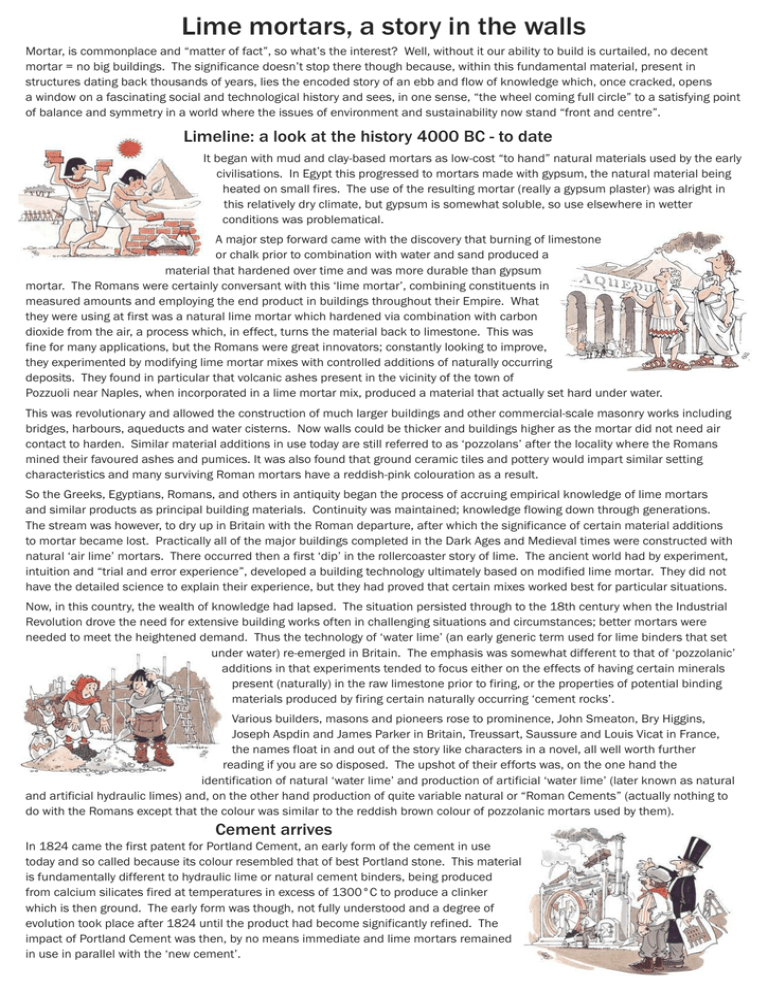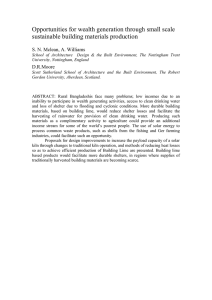History of Lime Mortar
advertisement

Lime mortars, a story in the walls Mortar, is commonplace and “matter of fact”, so what’s the interest? Well, without it our ability to build is curtailed, no decent mortar = no big buildings. The significance doesn’t stop there though because, within this fundamental material, present in structures dating back thousands of years, lies the encoded story of an ebb and flow of knowledge which, once cracked, opens a window on a fascinating social and technological history and sees, in one sense, “the wheel coming full circle” to a satisfying point of balance and symmetry in a world where the issues of environment and sustainability now stand “front and centre”. Limeline: a look at the history 4000 BC - to date It began with mud and clay-based mortars as low-cost “to hand” natural materials used by the early civilisations. In Egypt this progressed to mortars made with gypsum, the natural material being heated on small fires. The use of the resulting mortar (really a gypsum plaster) was alright in this relatively dry climate, but gypsum is somewhat soluble, so use elsewhere in wetter conditions was problematical. A major step forward came with the discovery that burning of limestone or chalk prior to combination with water and sand produced a material that hardened over time and was more durable than gypsum mortar. The Romans were certainly conversant with this ‘lime mortar’, combining constituents in measured amounts and employing the end product in buildings throughout their Empire. What they were using at first was a natural lime mortar which hardened via combination with carbon dioxide from the air, a process which, in effect, turns the material back to limestone. This was fine for many applications, but the Romans were great innovators; constantly looking to improve, they experimented by modifying lime mortar mixes with controlled additions of naturally occurring deposits. They found in particular that volcanic ashes present in the vicinity of the town of Pozzuoli near Naples, when incorporated in a lime mortar mix, produced a material that actually set hard under water. This was revolutionary and allowed the construction of much larger buildings and other commercial-scale masonry works including bridges, harbours, aqueducts and water cisterns. Now walls could be thicker and buildings higher as the mortar did not need air contact to harden. Similar material additions in use today are still referred to as ‘pozzolans’ after the locality where the Romans mined their favoured ashes and pumices. It was also found that ground ceramic tiles and pottery would impart similar setting characteristics and many surviving Roman mortars have a reddish-pink colouration as a result. So the Greeks, Egyptians, Romans, and others in antiquity began the process of accruing empirical knowledge of lime mortars and similar products as principal building materials. Continuity was maintained; knowledge flowing down through generations. The stream was however, to dry up in Britain with the Roman departure, after which the significance of certain material additions to mortar became lost. Practically all of the major buildings completed in the Dark Ages and Medieval times were constructed with natural ‘air lime’ mortars. There occurred then a first ‘dip’ in the rollercoaster story of lime. The ancient world had by experiment, intuition and “trial and error experience”, developed a building technology ultimately based on modified lime mortar. They did not have the detailed science to explain their experience, but they had proved that certain mixes worked best for particular situations. Now, in this country, the wealth of knowledge had lapsed. The situation persisted through to the 18th century when the Industrial Revolution drove the need for extensive building works often in challenging situations and circumstances; better mortars were needed to meet the heightened demand. Thus the technology of ‘water lime’ (an early generic term used for lime binders that set under water) re-emerged in Britain. The emphasis was somewhat different to that of ‘pozzolanic’ additions in that experiments tended to focus either on the effects of having certain minerals present (naturally) in the raw limestone prior to firing, or the properties of potential binding materials produced by firing certain naturally occurring ‘cement rocks’. Various builders, masons and pioneers rose to prominence, John Smeaton, Bry Higgins, Joseph Aspdin and James Parker in Britain, Treussart, Saussure and Louis Vicat in France, the names float in and out of the story like characters in a novel, all well worth further reading if you are so disposed. The upshot of their efforts was, on the one hand the identification of natural ‘water lime’ and production of artificial ‘water lime’ (later known as natural and artificial hydraulic limes) and, on the other hand production of quite variable natural or “Roman Cements” (actually nothing to do with the Romans except that the colour was similar to the reddish brown colour of pozzolanic mortars used by them). Cement arrives In 1824 came the first patent for Portland Cement, an early form of the cement in use today and so called because its colour resembled that of best Portland stone. This material is fundamentally different to hydraulic lime or natural cement binders, being produced from calcium silicates fired at temperatures in excess of 1300°C to produce a clinker which is then ground. The early form was though, not fully understood and a degree of evolution took place after 1824 until the product had become significantly refined. The impact of Portland Cement was then, by no means immediate and lime mortars remained in use in parallel with the ‘new cement’. Come the 20th century the use of lime mortars was undergoing a ‘second dip’ on the rollercoaster ride. The popularity of Portland cement, a material which set hard and relatively quickly and could be used in most weathers by a workforce with less specific skills, was increased by the need for faster rates of construction driven, amongst other things, by World War 1 and corresponding investment in the cement industry up to and after World War 2, when the need for extensive re-building demanded mass production of construction materials. Portland cement was in the ascendancy, lime slipped from use to the point where we had all but lost the ability to use it and equally importantly, the knowledge and acceptance of the reasons why. Therein lay the contributory causes of a wrong turn that would, in due course, come back to haunt us. Portland cement had come to the fore and was clearly here to stay. No argument there, its use in the modern world is assured. The problem would come with the growing awareness of the need to preserve historic buildings, structures and monuments. Re-education In the UK the importance of preserving our building heritage and historic environment was recognised from the late 19th century onwards with the formation of various local and national bodies and societies dedicated to this end. The will, resolve, and enthusiasm were there in spades and, with a range of cement based materials now available, well intentioned repair and restoration works forged ahead. With hindsight, it is clear that successful repair of older buildings, without inflicting damage, requires full understanding of both structural and architectural qualities and the construction materials and methods used. The trouble was that we had lost the knowledge of lime and its inherent qualities, the very material used in the majority of such buildings. As a result, a significant amount of repair and restoration work carried out in the 20th century involved Portland cement based materials applied to existing lime mortar masonry. The extent of the error has emerged in more recent times with the realisation, via unfortunate experiences, that lime and cement materials, though both fine in their own rights, are incompatible in many ways, particularly in terms of flexibility and vapour / moisture permeability. Their co-presence in a structure more often than not leads to damage and disruption to the construction fabric and associated materials, such damage arising from factors including cracking, dampness, freeze/thaw disruption and soluble salt crystallisation. Full circle The lessons have now been learnt; the importance of identifying the precise nature and means of production of historic mortars and lime based materials accepted. Careful sampling followed by laboratory analysis and evaluation of test results now forms a vital step in the repair and conservation process. It is here that the wheel has come full circle for, unlike our ancestors, we now have the analytical techniques and ability to interpret and understand the science, enabling, in turn, suitable matching and compatibility of materials from simple issues of colour and aesthetics to more complex questions of in-situ characteristics and performance. This is certainly the experience of Kiwa CMT Testing; recent years seeing a marked increase in requests for testing of existing mortars used in various notable structures from fortifications, country houses and churches to mills, underground reservoirs, bridges and weirs. In the course of this we have discovered where constituents were sourced and processed, how the mortars were mixed and placed and details of significant impacts sustained during their service time to date. A whole history of building and construction is being brought back to life, with the recovered and newly enhanced knowledge restoring lime to its rightful place in the scheme of things As a country steeped in history we can now conduct appropriate and sympathetic repairs, preserving an illustrious past for future generations whilst tipping our hats to those who laboured on the great buildings and works over the ages to date, drawing on and adding to a priceless library of knowledge into the bargain. The ghosts of the engineers, master masons and craftsmen may settle back and rest easy, their stories are, quite literally, coming out of the walls. MB - February 2013 Mike Barham Chief Chemist, Kiwa CMT Testing Ltd. mike.barham@kiwa.co.uk Kiwa CMT Testing provides a complete site investigation & testing service for the construction, civil engineering & environmental industries, including the provision of professional support, expertise and advice. From initial assessment to site sampling, laboratory testing and analysis and final reporting, services are carried out to UKAS accredited standards, by a dedicated in-house team with scientific and engineering backgrounds, covering environmental, geotechnical and structural elements for all stages and aspects of both residential and commercial building and construction projects. For further information contact 01332 383333 or e-mail cmtenquiries@kiwa.co.uk



